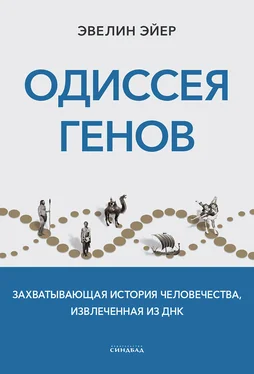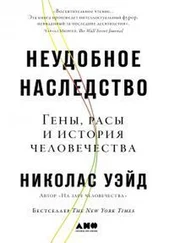Colonna, V. et al ., 2011, «A world in a grain of sand: Human history from genetic data», Genome Biology , 12(11).
Crawford, N. G. et al ., 2017, «Loci associated with skin pigmentation identified in African populations», Science , 358(6365).
Dannemann, M. et Kelso, J., 2017, «The contribution of Neanderthals to phenotypic variation in modern humans», American Journal of Human Genetics , 101(4), p. 578–589.
Deng, L. et Xu, S., 2018, «Adaptation of human skin color in various populations», Hereditas , 155(1).
Donnelly, M. P. et al ., 2012, «A global view of the OCA2-HERC2 region and pigmentation», Human Genetics , 131(5), p. 683–696.
Fan, S. et al ., 2016, «Review of recent human adaptation», Science , 354(6308), p. 54–59.
Fu, Q. et al ., 2014, «Genome sequence of a 45,000-year-old modern human from western Siberia», Nature , 514(7253), p. 445–449.
Fu, Q. et al ., 2016, «The genetic history of Ice Age Europe», Nature , 534(7606), p. 200–205.
Fumagalli, M. et al ., 2015, «Greenlandic Inuit show genetic signatures of diet and climate adaptation», 349(6254), p. 1343–1347.
Günther, T. et Jakobsson, M., 2016, «Genes mirror migrations and cultures in prehistoric Europe — a population genomic perspective», Current Opinion in Genetics and Development , 41, p. 115–123.
Günther, T. et al ., 2018, «Population genomics of Mesolithic Scandinavia: Investigating early postglacial migration routes and high-latitude adaptation», PLoS Biology , 16(1), p. 1–22.
Hay, S. I. et al ., 2004, «The global distribution and population at risk of malaria: past, present, and future», The Lancet. Infectious Diseases , 4(6), p. 327–336.
Hellenthal, G. et al ., 2014, «A genetic atlas of human admixture history», Science , 343(6172), p. 747–751.
Hlusko, L. J. et al ., 2018, «Environmental selection during the last ice age on the mother-to-infant transmission of vitamin D and fatty acids through breast milk», Proceedings of the National Academy of Sciences , 115(19).
Hublin, J. J., 2015, «The modern human colonization of western Eurasia: When and where?», Quaternary Science Reviews , 118, p. 194–210.
Huerta-Sánchez, E. et al ., 2014, «Altitude adaptation in Tibetans caused by introgression of Denisovan-like DNA», Nature , 512(7513), p. 194–197.
Ilardo, M. A. et al ., 2018, «Physiological and Genetic Adaptations to Diving in Sea Nomads», Cell , 173(3), p. 569–580.
Ingicco, T. et al ., 2018, «Earliest known hominin activity in the Philippines by 709 thousand years ago», Nature , 557(7704), p. 233–237.
Jablonski, N. G., 2004, «The evolution of human skin and skin color», Annual Review of Anthropology , 33(1), p. 585–623.
Jablonski, N. G. et Chaplin, G., 2017, «The colours of humanity: The evolution of pigmentation in the human lineage», Philosophical Transactions of the Royal Society B: Biological Sciences , 372(1724).
Jones, E. R. et al ., 2015, «Upper Palaeolithic genomes reveal deep roots of modern Eurasians», Nature Communications , 6, p. 1–8.
Kamberov, Y. G. et al ., 2013, «Modeling recent human evolution in mice by expression of a selected EDAR variant», Cell , 152(4), p. 691–702.
Karlsson, E. K. et al ., 2014, «Natural selection and infectious disease in human populations», Nature Publishing Group , 15(6), p. 379–393.
Kubo, D. et al ., 2013, «Brain size of Homo floresiensis and its evolutionary implications», Proceedings of the Royal Society B: Biological Sciences , 280(1760).
Lachance, J. et al ., 2012, «Evolutionary history and adaptation from high-coverage whole-genome sequences of diverse African hunter-gatherers», Cell , 150(3), p. 457–469.
Lalueza-Fox, C. et al ., 2007, «A melanocortin 1 receptor allele suggests varying pigmentation among Neanderthals», Science , 318(5855), p. 1453–1455.
Lazaridis, I., 2018, «The evolutionary history of human populations in Europe», Current Opinion in Genetics and Development , 53, p. 21–27.
Lazaridis, I. et al ., 2014, «Ancient human genomes suggest three ancestral populations for present-day Europeans», Nature , 513(7518), p. 409–413.
Llamas, B. et al ., 2017, «Human evolution: A tale from ancient genomes», Philosophical Transactions of the Royal Society B: Biological Sciences , 372(1713).
Lopez, M. et al ., 2019, «Genomic evidence for local adaptation of hunter-gatherers to the African rainforest», Current Biology , 29(17), p. 2926–2935.
Malaspinas, A. S. et al ., 2016, «A genomic history of Aboriginal Australia», Nature , 538(7624), p. 207–214.
Marciniak, S. et Perry, G. H., 2017, «Harnessing ancient genomes to study the history of human adaptation», Nature Reviews Genetics , 18(11), p. 659–674.
Martin, A. R. et al ., 2017, «An unexpectedly complex architecture for skin pigmentation in Africans», Cell , 171(6), p. 1340–1353.
Martinez-Cruz, B. et al ., 2011, «In the heartland of Eurasia: the multilocus genetic landscape of Central Asian populations», European Journal of Human Genetics , 19(2), p. 216.
Mathieson, I. et al ., 2015, «Genome-wide patterns of selection in 230 ancient Eurasians», Nature , 528(7583).
McColl, H. et al ., 2018, «The prehistoric peopling of Southeast Asia», Science , 361(6397).
Moore, L. G. et al ., 2001, «Tibetan protection from intrauterine growth restriction (IUGR) and reproductive loss at high altitude», American Journal of Human Biology , 13(5), p. 635–644.
Nakagome, S. et al ., 2015, «Estimating the ages of selection signals from different epochs in human history», Molecular Biology and Evolution , 33(3), p. 657–669.
Nielsen, R. et al ., 2017, «Tracing the peopling of the world through genomics», Nature , 541(7637), p. 302–310.
Norton, H. L. et al ., 2007, «Genetic evidence for the convergent evolution of light skin in Europeans and East Asians», Molecular Biology and Evolution , 24(3), p. 710–722.
O’Connell, J. F. et al ., 2018, «When did Homo sapiens first reach Southeast Asia and Sahul?», Proceedings of the National Academy of Sciences , 115(34), p. 8482–8490.
Olalde, I. et al ., 2014, «Derived immune and ancestral pigmentation alleles in a 7,000-year-old Mesolithic European», Nature , 507(7491), p. 225–228.
Pagani, L. et al ., 2016, «Genomic analyses inform on migration events during the peopling of Eurasia», Nature , 538(7624), p. 238–242.
Palstra, F. P. et al ., 2015, «Statistical inference on genetic data reveals the complex demographic history of human populations in Central Asia», Molecular Biology and Evolution , 32(6), p. 1411–1424.
Patin, E. et al ., 2009, «Inferring the demographic history of African farmers and Pygmy hunter-gatherers using a multilocus resequencing data set», PLoS Genetics , 5(4).
Patin, E. et al ., 2017, «Dispersals and genetic adaptation of Bantu-speaking populations in Africa and North America», Science , 356(6337), p. 543–546.
Pemberton, T. J. et al ., 2018, «A genome scan for genes underlying adult body size differences between Central African hunter-gatherers and farmers», Human Genetics , 137(6–7), p. 487–509.
Читать дальше
Конец ознакомительного отрывка
Купить книгу












